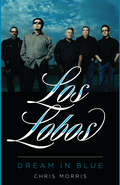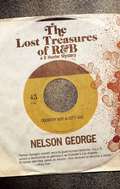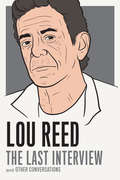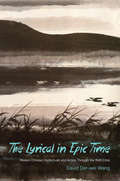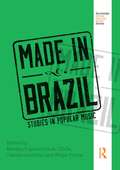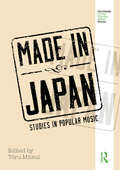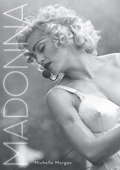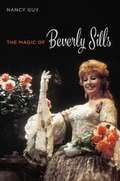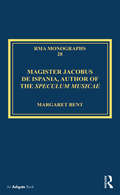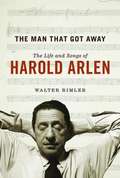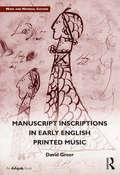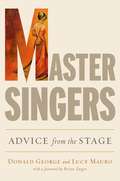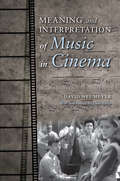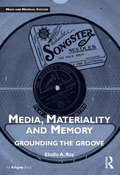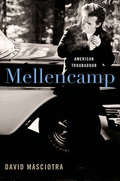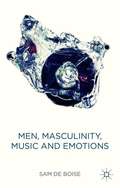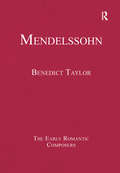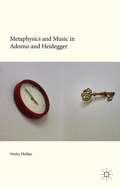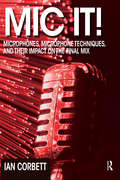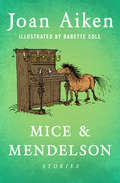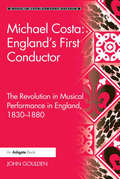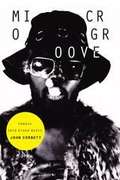- Table View
- List View
Los Lobos: Dream in Blue (American Music Series)
by Chris MorrisLos Lobos leaped into the national spotlight in 1987, when their cover of &“La Bamba&” became a No. 1 hit. But what looked like an overnight achievement to the band&’s new fans was actually a way station in a long musical journey that began in East Los Angeles in 1973 and is still going strong. Across four decades, Los Lobos (Cesar Rosas, Conrad Lozano, David Hidalgo, Louie Pérez, and Steve Berlin) have ranged through virtually the entire breadth of American vernacular music, from rockabilly to primal punk rock, R&B to country and folk, Mexican son jarocho to Tex-Mex conjunto and Latin American cumbia. Their sui generis sound has sold millions of albums and won acclaim from fans and critics alike, including three Grammy Awards. Los Lobos, the first book on this unique band, traces the entire arc of the band&’s career. Music journalist Chris Morris draws on new interviews with Los Lobos members and their principal collaborators, as well as his own reporting since the early 1980s, to recount the evolution of Los Lobos&’s music. He describes the creation of every album, lingering over highlights such as How Will the Wolf Survive?, La Pistola y El Corazon, and Kiko, while following the band&’s trajectory from playing Mexican folk music at weddings and dances in East L.A. to international stardom and major-label success, as well as their independent work in the new millennium. Giving one of the longest-lived and most-honored American rock bands its due, Los Lobos celebrates the expansive reach and creative experimentalism that few other bands can match.
The Lost Treasures of R&B (A D Hunter Mystery #0)
by Nelson GeorgeNominated for the Brooklyn Public Library's Brooklyn Eagles Literary Prize for Fiction"This is a fine mystery and [protagonist] D Hunter is as world weary, yet steadfast, as Philip Marloew, Spenser, Dave Robicheaux, or Easy Rawlins. A definite yes to purchase for both mystery and African American collections."--Library Journal (Starred Review, Pick of the Month)"George covers a lot of ground with style: the rhythm-and-blues music scene past and present, the sometimes startling evolution of Brooklyn and its environs, and the multitude of hangers-on, wannabes, and grifters who want a piece of the action."--Publishers Weekly"Real relationships and real talk frame the mashup of mysteries in George's street-framed series."--Kirkus Reviews"The wonderful sing-song street slang dialogue and esoteric industry knowledge make The Lost Treasures of R&B a richly entertaining addition to George's evolving series."--Shelf Awareness"George uses The Lost Treasures of R&B to tackle the hot-button issue of the gentrification of Brooklyn (and elsewhere) as protagonist D struggles to come to terms with the ghosts of his childhood in 'old Brooklyn.'"--Philadelphia Tribune"Written in the spirit of authors such as Walter Mosley and Donald Goines...The book blends music from the past with thug appeal of the present to appeal to young and old alike."--Baltimore Times"George is a historian of his culture."--The Stranger"Hunter is back in Brooklyn solving a mystery that has a backdrop firmly on the R&B scene."--NBCBLK, 14 Books to Read This Black History Month"Like its predecessor this installment of D's story fuses music, history, and crime on the streets of New York."--Flavorpill NYC"Nelson George delivers an entertaining and hard-boiled look at the music scene, and raises the question of proprietary rights and black culture."--MysteryPeople, One of Three Picks for February"As a huge R&B fan, when I ran across the title, The Lost Treasures of R&B, I just had to read it...and I'm glad I did."--Underrated ReadsProfessional bodyguard D Hunter takes a gig protecting rapper Asya Roc at an underground fight club in poverty-stricken Brownsville, Brooklyn. Unknown to D, the rapper has arranged to purchase illegal guns at the event. An acquaintance of D from the streets (and from the novel The Plot Against Hip Hop) named Ice turns out to be the courier.During the exchange a robbery is attempted. Ice is wounded. D gets Asya Roc to safety but is then chased by two gunmen because he has the bag containing the guns. This lethal chase ends under the elevated subway where D and the two gunmen run into a corrupt detective named Rivera. A bloody shootout ensues.D, who has just moved back to Brooklyn after decades in Manhattan, finds himself involved in multiple mysteries. Who were the gunmen? Why were they after the guns? Who was being set up--Asya Roc or Ice? Meanwhile, he gets a much-needed paying assignment to track down the rarest soul music single ever recorded.With gentrifying Brooklyn as the backdrop, D works to unravel various mysteries--both criminal and musical--while coming to terms with the failure of his security company and the ghosts of his childhood in "old Brooklyn." Like its predecessors The Accidental Hunter and The Plot Against Hip Hop, The Lost Treasures of R&B uses pop music as the backdrop for a noir-flavored big-city tale.
Lou Reed: The Last Interview
by Lou ReedA revealing collection of interviews with one of the greatest artists in the history of rock 'n' roll--as brilliant, punchy, and blustery as the man himself In this collection of powerful interviews given over thirty years--including his final interview--Lou Reed oscillates between losing patience with his interviewers (he was famous for walking out on them) and sharing profound observations on the human experience, especially as he reflects on poetry and novels, the joy of live performances, and the power of sound. In conversation with legendary rock critics and authors he respected, Reed's interviews are as pithy and brilliant as the man himself.From the Trade Paperback edition.
The Lyrical in Epic Time: Modern Chinese Intellectuals and Artists Through the 1949 Crisis
by David Der-wei WangIn this book, David Der-wei Wang uses the lyrical to rethink the dynamics of Chinese modernity. Although the form may seem unusual for representing China's social and political crises in the mid-twentieth century, Wang contends that national cataclysm and mass movements intensified Chinese lyricism in extraordinary ways. Wang calls attention to the form's vigor and variety at an unlikely juncture in Chinese history and the precarious consequences it brought about: betrayal, self-abjuration, suicide, and silence. Despite their divergent backgrounds and commitments, the writers, artists, and intellectuals discussed in this book all took lyricism as a way to explore selfhood in relation to solidarity, the role of the artist in history, and the potential for poetry to illuminate crisis. They experimented with poetry, fiction, film, intellectual treatise, political manifesto, painting, calligraphy, and music. Western critics, Wang shows, also used lyricism to critique their perilous, epic time. He reads Martin Heidegger, Theodor Adorno, Cleanth Brooks, and Paul de Man, among others, to complete his portrait.The Chinese case only further intensifies the permeable nature of lyrical discourse, forcing us to reengage with the dominant role of revolution and enlightenment in shaping Chinese—and global—modernity. Wang's remarkable survey reestablishes Chinese lyricism's deep roots in its own native traditions, along with Western influences, and realizes the relevance of such a lyrical calling of the past century to our time.
Made in Brazil: Studies in Popular Music (Routledge Global Popular Music Series)
by Martha Tupinamba de Ulhoa Cláudia Azevedo Felipe TrottaMade in Brazil: Studies in Popular Music serves as a comprehensive and thorough introduction to the history, sociology, and musicology of twentieth-century Brazilian popular music. The volume consists of essays by scholars of Brazilian music, and covers the major figures, styles, and social contexts of pop music in Brazil. Each essay provides adequate context so readers understand why the figure or genre under discussion is of lasting significance to Brazilian popular music. The book first presents a general description of the history and background of popular music in Brazil, followed by essays that are organized into thematic sections: Samba and Choro; History, Memory, and Representations; Scenes and Artists; and Music, Market and New Media.
Made in Japan: Studies in Popular Music (Routledge Global Popular Music Series)
by Toru MitsuiMade in Japan serves as a comprehensive and rigorous introduction to the history, sociology, and musicology of contemporary Japanese popular music. Each essay, written by a leading scholar of Japanese music, covers the major figures, styles, and social contexts of pop music in Japan and provides adequate context so readers understand why the figure or genre under discussion is of lasting significance. The book first presents a general description of the history and background of popular music, followed by essays organized into thematic sections: Putting Japanese Popular Music in Perspective; Rockin’ Japan; and Japanese Popular Music and Visual Arts.
Madonna (Mammoth Bks.)
by Michelle MorganMadonna: singer, songwriter, actress, businesswoman, not to mention one of the most renowned cultural icons of the last three decades. Since her first, eponymous album, over thirty years ago Madonna has sold a remarkable 300 million records worldwide, making her the top-selling female recording artist of all time. Madonna is famous for continuously reinventing both her music and her image. By pushing the boundaries of mainstream popular music with both her lyrical content and the imagery in her music videos she achieved extraordinary popularity. Morgan offers a richly illustrated, comprehensive account of the artist's phenomenally successful career. Reviews, interviews, commentary, and Madonna's own words shed new light on her videos, books, tours, fashion, charity work and every other aspect of her life.
Madonna
by Michelle MorganMadonna: singer, songwriter, actress, businesswoman, not to mention one of the most renowned cultural icons of the last three decades. Since her first, eponymous album, over thirty years ago Madonna has sold a remarkable 300 million records worldwide, making her the top-selling female recording artist of all time.Madonna is famous for continuously reinventing both her music and her image. By pushing the boundaries of mainstream popular music with both her lyrical content and the imagery in her music videos she achieved extraordinary popularity. Morgan offers a richly illustrated, comprehensive account of the artist's phenomenally successful career shedding new light on her videos, books, tours, fashion, charity work and every other aspect of her life.Praise for Marilyn Monroe: Private and Undisclosed:'A gorgeous collection offering a fascinating insight into Monroe's personal life' Women & Home'A touching portrayal of the star in her more private moments' Empire'The most authoritative book on the star to date' Choice
The Magic of Beverly Sills
by Nancy GuyWith her superb coloratura soprano, passion for the world of opera, and down-to-earth personality, Beverly Sills made high art accessible to millions from the time of her meteoric rise to stardom in 1966 until her death in 2007. An unlikely pop culture phenomenon, Sills was equally at ease on talk shows, on the stage, and in the role of arts advocate and administrator. Merging archival research with her own love of Sills's music, Nancy Guy examines the singer-actress's artistry alongside the ineffable aspects of performance that earned Sills a passionate fandom. Guy mines the memories of colleagues, critics, and aficionados to recover something of the spell Sills wove for people on both sides of the footlights during the hot moments of onstage performance. At the same time, she analyzes essential questions raised by Sills's art and celebrity. How did Sills challenge the divide between elite and mass culture and build a fan base that crossed generations and socio-economic lines? Above all, how did Sills capture the unnameable magic that joins the members of an audience to a performer--and to one-another? Intimate and revealing, The Magic of Beverly Sills explores the alchemy of art, magnetism, community, and emotion that produced an American icon.
Magister Jacobus de Ispania, Author of the Speculum musicae (Royal Musical Association Monographs)
by Margaret BentThe Speculum musicae of the early fourteenth century, with nearly half a million words, is by a long way the largest medieval treatise on music, and probably the most learned. Only the final two books are about music as commonly understood: the other five invite further work by students of scholastic philosophy, theology and mathematics. For nearly a century, its author has been known as Jacques de Liège or Jacobus Leodiensis. ’Jacobus’ is certain, fixed by an acrostic declared within the text; Liège is hypothetical, based on evidence shown here to be less than secure. The one complete manuscript, Paris BnF lat. 7207, thought by its editor to be Florentine, can now be shown on the basis of its miniatures by Cristoforo Cortese to be from the Veneto, datable c. 1434-40. New documentary evidence in an Italian inventory, also from the Veneto, describes a lost copy of the treatise dating from before 1419, older than the surviving manuscript, and identifies its author as ’Magister Jacobus de Ispania’. If this had been known eighty years ago, the Liège hypothesis would never have taken root. It invites a new look at the geography and influences that played into this central document of medieval music theory. The two new attributes of ’Magister’ and ’de Ispania’ (i.e. a foreigner) prompted an extensive search in published indexes for possible identities. Surprisingly few candidates of this name emerged, and only one in the right date range. It is here suggested that the author of the Speculum is either someone who left no paper trail or James of Spain, a nephew of Eleanor of Castile, wife of King Edward I, whose career is documented mostly in England. He was an illegitimate son of Eleanor’s older half-brother, the Infante Enrique of Castile. Documentary evidence shows that he was a wealthy and well-travelled royal prince who was also an Oxford magister. The book traces his career and the likelihood of his authorship of the Speculum musicae.
The Making of Liturgy in the Ottonian Church
by Henry ParkesThis highly original study examines the history and religious life of the Ottonian Church through its ritual books. With forensic attention to the writing and design of four important manuscripts from the city of Mainz - a musician's troper, a priest's ritual handbook, a bishop's pontifical and a copy of the enigmatic compilation now known as the 'Romano-German Pontifical' - Henry Parkes transforms liturgical sources into eloquent witnesses to the ecclesiastical history of early medieval Germany. He also presents the first comprehensive revision of Michel Andrieu's influential 'Romano-German Pontifical' theory, from the dual perspective of Mainz's cathedral of St Martin and its Benedictine monastery of St Alban. Challenging long-held assumptions about the geographies of Ottonian power, in particular the central role of Mainz and its archbishops, the book opens up important new ways of understanding how religious ritual was organised, transmitted and perceived.
The Man That Got Away: The Life and Songs of Harold Arlen (Music in American Life)
by Walter RimlerOver the Rainbow, "Stormy Weather," and "One for My Baby" are just a few of Harold Arlen's well-loved compositions. Yet his name is hardly known--except to the musicians who venerate him. At a gathering of songwriters George Gershwin called him "the best of us." Irving Berlin agreed. Paul McCartney sent him a fan letter and became his publisher. Bob Dylan wrote of his fascination with Arlen's "bittersweet, lonely world." A cantor's son, Arlen believed his music was from a place outside himself, a place that also sent tragedy. When his wife became mentally ill and was institutionalized he turned to alcohol. It nearly killed him. But the beautiful songs kept coming: "Blues in the Night," "My Shining Hour," "Come Rain or Come Shine," and "The Man That Got Away." Walter Rimler drew on interviews with friends and associates of Arlen and on newly available archives to write this intimate portrait of a genius whose work is a pillar of the Great American Songbook.
The Manual of Musical Instrument Conservation
by Stewart PollensThis is the first book to combine museum-based conservation techniques with practical instructions on the maintenance, repair, adjustment, and tuning of virtually every type of historical musical instrument. As one of the world's leading conservators of musical instruments, Stewart Pollens gives practical advice on the handling, storage, display and use of historic musical instruments in museums and other settings, and provides technical information on such wide-ranging subjects as acoustics, cleaning, climate control, corrosion, disinfestation, conservation ethics, historic stringing practice, measurement and historic metrology, retouching, tuning historic temperaments, varnish and writing reports. There are informative essays on the conservation of each of the major musical instrument groups, the treatment of paper, textiles, wood and metal, as well as historic techniques of wood and metalworking as they apply to musical instrument making and repair. This is a practical guide that includes equations, formulas, tables and step-by-step instructions.
Manuscript Inscriptions in Early English Printed Music (Music and Material Culture)
by David GreerWho were the first owners of the music published in England in the sixteenth and early seventeenth centuries? Who went to ‘the dwelling house of … T. East, by Paules wharfe’ and bought a copy of Byrd’s Psalmes, sonets, & songs when it appeared in 1588? Who purchased a copy of Dowland’s First booke of songes in 1597? What other books formed part of their music library? In this survey of surviving books of music published before 1640, David Greer has gleaned information about the books’ early and subsequent owners by studying the traces they left in the books themselves: handwritten inscriptions, including names and other marks of ownership - even the scribbles and drawings a child of the family might put into a book left lying about. The result is a treasure trove of information about musical culture in early modern England. From inscriptions and marks of ownership Greer has been able to re-assemble early sets of partbooks, as well as collections of books once bound together. The search has also turned up new music. At a time when paper was expensive, new pieces were copied into blank spaces in printed books. In these jottings we find a ‘hidden repertory’ of music, some of it otherwise undiscovered music by known composers. In other cases, we see owners altering the words of songs, to suit new and personal purposes: a love-song in praise of Daphne becomes a heartfelt song to ‘my Jesus’; and ‘Faire Leonilla’ becomes Ophelia (perhaps the first mention of this character in Hamlet outside the play itself). On a more practical level, the users of the music sometimes made corrections to printing errors, and there are indications that some of these were last-minute corrections made in the printing-house (a useful guide for the modern editor). The temptation to ‘scribble in books’ was as irresistible to some Elizabethans as it is to some of us today. In doing so they left us clues to their identity, how they kept their music, how they used it, and the multifarious ways in which it played a part in their lives.
Master Singers: Advice From the Stage
by Donald George Lucy MauroThe book provides vocalists making the transition from student to professional with advice on matters ranging from technique and its practical application for effective stage projection to the practicalities of the business of professional singing.
Meaning and Interpretation of Music in Cinema
by David P. NeumeyerBy exploring the relationship between music and the moving image in film narrative, David Neumeyer shows that film music is not conceptually separate from sound or dialogue, but that all three are manipulated and continually interact in the larger acoustical world of the sound track. In a medium in which the image has traditionally trumped sound, Neumeyer turns our attention to the voice as the mechanism through which narrative (dialog, speech) and sound (sound effects, music) come together. Complemented by music examples, illustrations, and contributions by James Buhler, Meaning and Interpretation of Music in Cinema is the capstone of Neumeyer's 25-year project in the analysis and interpretation of music in film.
Media, Materiality and Memory: Grounding the Groove (Music and Material Culture)
by Elodie A. RoyMedia, Materiality and Memory: Grounding the Groove examines the entwinement of material music objects, technology and memory in relation to a range of independent record labels, including Sarah Records, Ghost Box and Finders Keepers. Moving from Edison’s phonograph to digital music files, from record collections to online archives, Roy argues that materiality plays a crucial role in constructing and understanding the territory of recorded sound. How do musical objects ‘write’ cultural narratives? How can we unearth and reactivate past histories by looking at yesterday’s media formats? What is the nature, and fate, of the physical archive in an increasingly dematerialized world? In what ways do physical and digital musical objects coexist and intersect? With its innovative theoretical approach, the book explores the implications of materialization in the fashioning of a musical world and its cultural transmission. A substantial contribution to the field of music and material culture studies, Media, Materiality and Memory also provides a nuanced and timely reflection on nostalgia and forgetting in the digital age.
Mellencamp: American Troubadour
by David MasciotraThroughout his prolific career, John Mellencamp has performed more than twenty Top 40 hits, has been nominated for thirteen Grammy Awards, and has been inducted into the Rock and Roll Hall of Fame. Hits like "Jack and Diane," "Small Town," and "Cherry Bomb" are iconic American songs that have played an important role in defining midwestern music and developing the rock genre. Despite his critical and commercial success, however, the rough guy from a small town writing songs about everything he "learned about living" is often omitted from the ranks of America's songwriting elite.In Mellencamp, David Masciotra explores the life and career of one of America's most important and underrated songwriters, persuasively arguing that he deserves to be celebrated alongside artists like Bruce Springsteen, Neil Young, and Bob Dylan. Beginning with his modest beginnings in Seymour, Indiana, Masciotra details Mellencamp's road to fame, examining his struggles with the music industry and his persistent dedication to his midwestern roots. Shaking off the shortsighted "regionalist" stereotype and dismissing his assumed pop-star persona, Mellencamp found success by remaining true to where he came from.This thoughtful analysis highlights four decades of the artist's music, which has consistently elevated the dignity of everyday people and honored the quiet heroism of raising families and working hard. This first serious biography of the legendary musician will charm fans and music enthusiasts who are interested in the development of roots rock and Americana music.
Men, Masculinity, Music and Emotions
by Sam BoiseThis book looks at the historic and contemporary links between music's connection to emotions and men's supposed discomfort with their own emotional experience. Looking at music tastes and distaste, it demonstrates how a sociological analysis of music and gender can actually lead us to think about emotions and gender inequalities in different ways.
Mendelssohn: The Romantic Conception Of Cyclic Form
by Benedict TaylorThis volume of essays brings together a selection of the most significant and representative writings on Mendelssohn from the last fifty years. Divided into four main subject areas, it makes available twenty-two essays which have transformed scholarly awareness of this crucial and ever-popular nineteenth-century composer and musician; it also includes a specially commissioned introductory chapter which offers a critical overview of the last half century of Mendelssohn scholarship and the direction of future research. The addition of new translations of two influential essays by Carl Dahlhaus, hitherto unavailable in English, adds to the value of this volume which brings back in to circulation important scholarly works and constitutes an indispensable reference work for Mendelssohn scholars.
Metaphysics and Music in Adorno and Heidegger
by Wesley PhillipsMetaphysics and Music in Adorno and Heidegger seeks to show how two notoriously opposed German philosophers share a rethinking of the contemporary possibility of metaphysics via notions of music and waiting. Interweaving discourses of philosophy, critical theory, cultural studies and aesthetics, the book puts forward the idea of an expression of waiting in vain as constituting an alternative comportment of promise, in a situation where the promise of metaphysics is questionable. These findings are connected to the broader, historical materialist promise of social change. Throughout the book, the Italian composer Luigi Nono is taken to exemplify the temporal and spatial character of this expression. Metaphysics and Music in Adorno and Heidegger includes new interpretations of both Adorno and Heidegger, and will be of interest to students and scholars of both critical aesthetics and radical thought.
Mic It!: Microphones, Microphone Techniques, And Their Impact On The Final Mix
by Ian CorbettCapture great sound in the first place, and spend less time "fixing it in the mix" with Ian Corbett’s Mic It! Microphones, Microphone Techniques, and Their Impact on the Final Mix. With his expert guidance, you’ll quickly understand essential audio concepts as they relate to microphones and mic techniques, and learn how to apply them to your recording situation. Whether you only ever buy one microphone, are equipping a studio on a budget, or have a vast selection of great mics to use, you’ll learn to better use whatever tools you have. Mic It! gives you the background to design and discover your own solutions to record the best sound possible. The information in these pages will help you record great source tracks that can be easily developed into anything from ultra-clean mixes to huge, organic soundscapes. Beginning with essential audio theory, then discussing the desirable characteristics of good sound and the elements of a good stereo recording, the book covers microphones, mono and stereo mic techniques, the effect of the recording space or room, and large classical and jazz ensemble recording. A variety of mic techniques for vocals and instruments (both individual and groups) are presented, ranging from vital knowledge that no novice should be without, to advanced techniques that more experienced engineers can explore to benefit and vary the sound of their recordings. Corbett explains large room vs. layer-by-layer small-room recording situations, presents the best techniques for each, and shares typical production challenges and their resolutions. The book provides in depth information on how different mic techniques can be used, modified and fine-tuned to capture not only the best sound, but the best sound for the mix, as well as how to approach and set up the recording session, mixing, and avoid common recording and mixing mistakes.
Mice & Mendelson: Stories
by Joan Aiken Babette ColeThe hilarious adventures of an elderly pony named Mr. Mendelson and his 2 piano-playing field mice friends In a wild, remote place called Midnight Park, there lives an elderly Orkney pony named Mr. Mendelson. He is only 3 feet tall, is black all over, and has a big, handsome head. For years, Mendelson has been ridden by Sam, who is now old enough to go away to boarding school. But before he leaves, Sam asks his grandfather to buy Mendelson a piano. Not for Mendelson, because everyone knows horses can't play the piano, but for Mendelson's friends Gertrude and Bertha--2 talented field mice who were taught to play by a musician who lives in the park. Delighted when the piano is placed under a large oak tree, the mice promise Mendelson a concert at 6 p.m. every night. With 7 enchanting tales, Mice & Mendelson takes readers into the rich world of these farmyard friends. In 1 story, the old pony gets a bad case of the hiccups. In another, he learns to tell time with the help of Gertrude and Bertha, who wind his watch every day. In further adventures, Mendelson saves the moon from drowning in the pond and the village Christmas trees from being stolen. But what Mendelson really wants is to learn how to fly, and surprisingly his wish almost comes true--no thanks to the wicked ways of the scheming gipsy Dan Sligo! This ebook features illustrations by Babette Cole and a personal history of Joan Aiken including rare images from the author's estate.
Michael Costa: The Revolution in Musical Performance in England, 1830-1880 (Music in Nineteenth-Century Britain)
by John GouldenAmong the major changes that swept through the music industry during the mid-nineteenth century, one that has received little attention is how musical performances were managed and directed. Yet this was arguably the most radical change of all: from a loose control shared between the violin-leader, musical director and maestro al cembalo to a system of tight and unified control under a professional conductor-manager. This process brought with it not only baton conducting in its modern form, but also higher standards of training and discipline, a new orchestral lay-out and a more focused rehearsal regime. The resulting rise in standards of performance was arguably the greatest achievement of English music in the otherwise rather barren mid-Victorian period. The key figure in this process was Michael Costa, who built for himself unprecedented contractual powers and used his awesome personal authority to impose reform on the three main institutions of mid-Victorian music: the opera houses, the Philharmonic and the Sacred Harmonic Society. He was a central figure in the battles between the two rival opera houses, between the Philharmonic and the New Philharmonic, and between the venerable Ancient Concerts and the mass festival events of the Sacred Harmonic Society. Costa’s uniquely powerful position in the operatic, symphonic and choral world and the rapidity with which he was forgotten after his death provide a fascinating insight into the politics and changing aesthetics of the Victorian musical world.
Microgroove: Forays into Other Music
by John CorbettMicrogroove continues John Corbett's exploration of diverse musics, with essays, interviews, and musician profiles that focus on jazz, improvised music, contemporary classical, rock, folk, blues, post-punk, and cartoon music. Corbett's approach to writing is as polymorphous as the music, ranging from oral history and journalistic portraiture to deeply engaged cultural critique. Corbett advocates for the relevance of "little" music, which despite its smaller audience is of enormous cultural significance. He writes on musicians as varied as Sun Ra, PJ Harvey, Koko Taylor, Steve Lacy, and Helmut Lachenmann. Among other topics, he discusses recording formats; the relationship between music and visual art, dance, and poetry; and, with Terri Kapsalis, the role of female orgasm sounds in contemporary popular music. Above all, Corbett privileges the importance of improvisation; he insists on the need to pay close attention to "other" music and celebrates its ability to open up pathways to new ideas, fresh modes of expression, and unforeseen ways of knowing.
